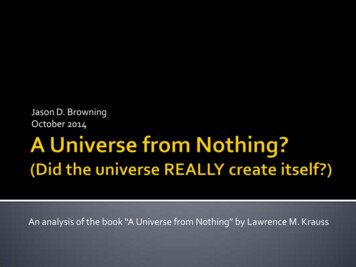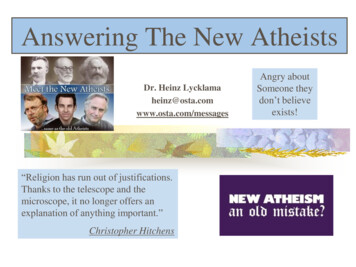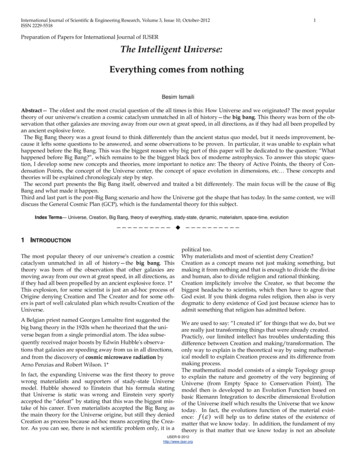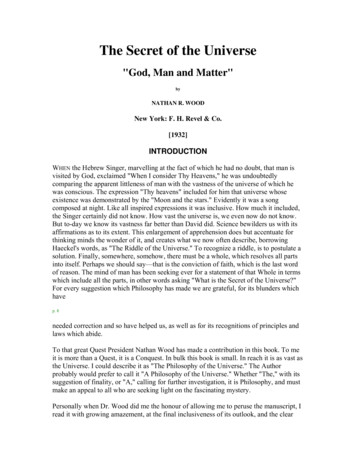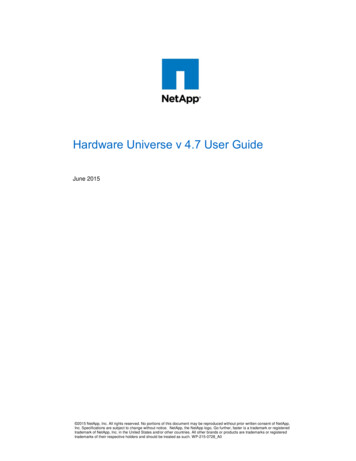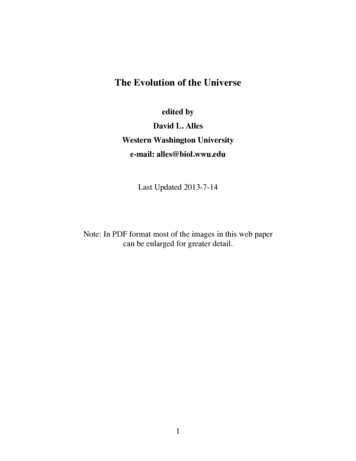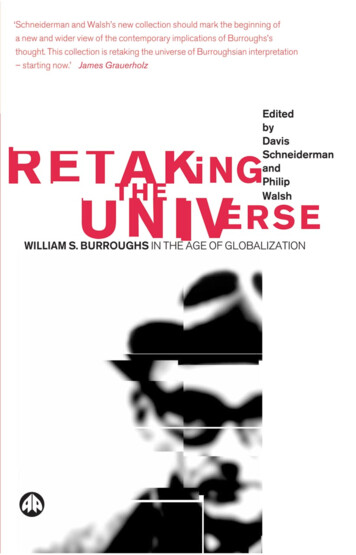
Transcription
Schn-FM.qxd 3/27/04 11:25 AM Page iiiRetaking the UniverseWilliam S. Burroughsin the Age of GlobalizationEdited byDavis Schneiderman and Philip Walsh
Schn-FM.qxd 3/27/04 11:25 AM Page ivFirst published 2004 by Pluto Press345 Archway Road, London N6 5AA22883 Quicksilver Drive, Sterling, VA 20166–2012, USAwww.plutobooks.comCopyright Davis Schneiderman and Philip Walsh 2004The right of the individual contributors to be identified as the authorsof this work has been asserted by them in accordance with theCopyright, Designs and Patents Act 1988.British Library Cataloguing in Publication DataA catalogue record for this book is available from the British LibraryISBN 0 7453 2082 1 hardbackISBN 0 7453 2081 3 paperbackLibrary of Congress Cataloging-in-Publication DataRetaking the Universe: William S. Burroughs in the Age of Globalization/edited by Davis Schneiderman and Philip Walsh.p. cm.Includes bibliographical references.ISBN 0-7453-2082-1 (hbk.)—ISBN 0-7453-2081-3 (pbk.)1. Burroughs, William S., 1914—Criticism and interpretation2. Homosexuality and literature—United States—History—20th century.3. Sexual orientation in literature. 4. Beat generation in literature.5. Narcotic habit in literature. I. Schneiderman, Davis. II. Walsh,Philip, 1965–PS3552.U75Z835 2004813 .54—dc22200302596310 9 8 7 6 5 4 3 2 1Designed and produced for Pluto Press byChase Publishing Services, Fortescue, Sidmouth, EX10 9QG, EnglandTypeset from disk by Newgen Imaging Systems (P) Ltd, IndiaPrinted and bound in the European Union byAntony Rowe Ltd, Chippenham and Eastbourne, England
Schn-FM.qxd 3/27/04 11:25 AM Page vContentsList of AbbreviationsviiAcknowledgmentsxForeword—Jennie SkerlxiIntroduction: Millions of People Reading the Same Words—Davis Schneiderman and Philip Walsh1Part I Theoretical Depositions1. Shift Coordinate Points: William S. Burroughs andContemporary Theory—Allen Hibbard2. Exposing the Reality Film: William S. BurroughsAmong the Situationists—Timothy S. Murphy3. Reactivating the Dialectic of Enlightenment:Burroughs as Critical Theorist—Philip Walsh4. Speculating Freedom: Addiction, Control and RescriptiveSubjectivity in the Work of William S. Burroughs—Jason Morelyle5. Excursus: Burroughs, Dada and Surrealism—Jon Longhi1329587487PART II Writing, Sign, Instrument: Languageand Technology6. Burroughs’s Writing Machines—Anthony Enns7. Totally Wired: Prepare Your Affidavits of Explanation—Edward Desautels8. New World Ordure: Burroughs, Globalization andthe Grotesque—Dennis McDanielv95116132
Schn-FM.qxd 3/27/04 11:25 AM Page vivi Contents9. Nothing Hear Now but the Recordings: Burroughs’s‘Double Resonance’—Davis Schneiderman10. Guerilla Conditions: Burroughs, Gysin and BalchGo to the Movies—Jamie Russell11. Cutting up Politics—Oliver Harris146161175PART III Alternatives: Realities and Resistances12. The Map and the Machine—John Vernon13. The High Priest and the Great Beast atThe Place of Dead Roads—Ron Roberts14. A Camera on Violence: Reality and Fiction inBlade Runner, a Movie—Roberta Fornari15. William S. Burroughs, Laughter andthe Avant-Garde—Katharine Streip16. Lemurian Time War—Cybernetic Culture Research Unit (Ccru)203225241258274Contributors’ Notes292Index295
Schn-FM.qxd 3/27/04 11:25 AM Page viiList of AbbreviationsThe many editions and printings of Burroughs’s large body of workpresent multiple challenges to any type of standardized referencesystem. Stories, essays, and entire novels appear in multiple publications, and in forms often distinct from their previous incarnations. This list of abbreviations should help the reader to not onlyidentify but also locate the texts to which the contributors refer. Tothis end, we have listed, whenever possible, widely availableeditions of Burroughs’s work.Major and single-volume text-based works written by or producedin concert with Burroughs are cited throughout this collectionaccording to this list. Sound works attributed in whole or in part toBurroughs, when cited in the essays, are also noted by abbreviations. Essays and stories that appear outside of the works listedbelow, unpublished letters, collections of interviews, and criticalworks about Burroughs referenced by the contributors, as well asother Burroughs’s written/sound/film work mentioned (but notspecifically cited) in this collection are listed in the Referencessection of the individual essays when appropriate.A note on the text: Throughout the references in this collection,the year that appears in the first parenthesis of a citation signals theyear of initial publication, and the second date indicates the year ofthe edition, printing, or publication cited in the collection.For more specific information and overviews of these issues inrelation to Burroughs’s work, see Joe Maynard and Barry Miles’sWilliam S. Burroughs: A Bibliography, 1953–73, and Barry Miles’sWilliam Burroughs: El Hombre Invisible.AMAPHBestBFBR(1985) The Adding Machine: Selected Essays (New York:Arcade, 1993).(1979) Ah Pook is Here and Other Texts (London: JohnCalder).(1998) The Best of William Burroughs from Giorno PoetrySystems, Disc 4 (Mouth Almighty Records, 314 536 704-2).(1984) The Burroughs File (San Francisco: City Lights).(1979) Blade Runner, a Movie (Berkeley: Blue Wind,1990).vii
Schn-FM.qxd 3/27/04 11:25 AM Page viiiviii List of GNENLPDRPGPOSQSAASM(2)TE(2)3M(1986) Break Through in Grey Room [Sub Rosa, CD006-8].Compilation of recordings from the 1960s and 1970s.(1986) The Cat Inside (USA: Penguin, 1992).(1965) Call Me Burroughs [Rhino Records, reissue 1995 R271848].(1981) Cities of the Red Night (New York: Picador, 2001).(1973) Exterminator! (New York: Penguin, 1979).Burroughs, W. S. and Van Sant, G. (1985) The Elvis of Letters[TK Records, 91CD001].(1970) Electronic Revolution (Bonn, Germany: ExpandedMedia Editions, 1976).(1991) Ghost of Chance (New York: Serpent’s Tail, 1995).(1953) Junky, unexpurgated edition (London: Penguin,1977). Originally published as Junkie by ‘William Lee’.[with Odier, D.] (1969) The Job: Interviews with William S.Burroughs, rev. edition, Grove, 1974 (New York: Penguin,1989).(1982) Letters To Allen Ginsberg 1953–1957 (New York: FullCourt).(2000) Last Words: The Final Journals of William S.Burroughs, Grauerholz, J. ed. (New York: Grove).(1993) The Letters of William S. Burroughs 1945–1959,Harris, O. ed. (New York: Viking).[with Gysin, B., Beiles, S., and Corso, G.] (1960) Minutes toGo (Paris: Two Cities).(1964) Nova Express (New York: Grove, 1992).(1959) Naked Lunch (New York: Grove, 1992).1(1983) The Place of Dead Roads (New York: Picador,2001).(1992) Painting and Guns (New York: Hanuman).(1973) Port of Saints, rev. edition (Berkeley, CA: Blue Wind,1980).(1985) Queer (New York: Viking Penguin, 1987).(1993) Spare Ass Annie and Other Tales [Island Records 162535 003-2].(1966) The Soft Machine, 2nd edition (New York: Grove,1992).2(1967) The Ticket that Exploded, 2nd edition (New York:Grove, 1992).3[with Gysin, B.] (1964–65, unpublished version) The ThirdMind (New York: Seaver Books/Viking, 1978).
Schn-FM.qxd 3/27/04 11:25 AM Page ixList of Abbreviations ixWBWLWSWVYL(1971) The Wild Boys: A Book of the Dead (New York: Grove,1992).(1987) The Western Lands (New York: Viking Penguin).(1973) White Subway (London: Aloes seolA).(1998) Word Virus: The William S Burroughs Reader,Grauerholz, J. and Silverberg, I. eds (New York: GrovePress).[with Allen Ginsberg] (1963) The Yage Letters (SanFrancisco: City Lights, 1990)1. Several editions of Naked Lunch from the early 1990s use thesame ISBN but have different pagination. The edition cited herecontains a Foreword by Terry Southern and an introductory piececalled ‘Naked Lunch on Trial’.2. Burroughs produced three distinct versions of The Soft Machine,including the second edition listed above, which is the mostwidely available. Oliver Harris’s essay, ‘Cutting Up Politics’, specifically references the second and third editions. The other two editions: (1961) The Soft Machine, 1st edition (Paris: Olympia) andSM3 (1968) The Soft Machine, 3rd edition (London: John Calder).3. Burroughs produced two distinct versions of The Ticket thatExploded, including the 2nd edition, listed above, which includesan appendix essay, ‘The Invisible Generation’ (1966). The firstediting: (1962) The Ticket that Exploded, 1st edition (Olympia:Paris).
Schn-FM.qxd 3/27/04 11:25 AM Page xAcknowledgmentsWe owe lavish thanks to the many people and institutions that havehelped this book find its way to publication. First, without a chancemeeting at Tompkins Cortland Community College in 2000, and achance discovery of a mutual interest in Burroughs, we would neverhave formed the friendship and intellectual partnership that hasproduced this text.Sincere thanks must be offered to the three Lake Forest Collegestudents who dedicated the summer after their freshman years (asparticipants in the Richter Scholar Program) to shepherd variousstages of this project toward completion. First, both MichaelHaining and Logan Dick provided valuable support in the proposalstage of the project, and their attention and interest carried fromthe summer of 2002 through their careful editing during the following year and a half. Second, Michael Wakcher dove fiercely intoeditorial work in the summer of 2003, distinguishing himself witha fine attention to detail and a desire to meet the highest standardsof accuracy and scholarship.Also, the generous support of Lake Forest College in the form ofsummer research grants, departmental encouragement, and collegiality, helped to make this a project whose long work was punctuated by the best sort of academic camaraderie.Many others, of course, have contributed in all sorts of tangibleand intangible ways. In no particular order, and with great fear ofomission, we wish to thank: Lisa Schneiderman, Ruth Schneiderman,Philip Schneiderman, Lennard J. Davis, John Vernon, William Haver,Joseph Bisz, Carlos Hernandez, J. Elizabeth Clark, Matt Laferty and, ofcourse, Nicola East and Kelly Haramis.Finally, we also wish to thank Pluto Press for their support, andKieran Macdonald for his excellent copy-editing.x
Schn-FM.qxd 3/27/04 11:25 AM Page xiForewordJennie SkerlIn our survey of the critical response to Burroughs from 1959 to1989, Robin Lydenberg and I observed that, decade by decade,Burroughs’s work has been seen as emblematic of his times. AsJ. G. Ballard remarked upon Burroughs’s death, ‘his weird geniuswas the perfect mirror of his times’ (cited by Caveney 1998:217).The 1950s saw Burroughs as a spiritual hero of an undergroundmovement that sought to create not only a new bohemia, but alsoa new consciousness. The legend of William S. Burroughs as a controlling and uncontrollable construct began before he publishedhis first novel, Junkie (1953), through the shaping of his personaby other writers in his circle ( Jack Kerouac, Allen Ginsberg, JohnClellon Holmes, Alan Ansen) and the gossip of the bohemiansubculture coming into being.The publication of Naked Lunch and the Nova trilogy in the early1960s led to intense critical debate on the morality or lack thereofin Burroughs’s work, beginning with the attempts at censorshipthat were made before the 1962 publication of Naked Lunch in theUS. Critical reactions were extravagant and irreconcilable: from‘[g]lug, glug, it tastes disgusting’ (TLS reviewer) to ‘possessed bygenius’ (Norman Mailer, Naked Lunch dust jacket). But both detractors and defenders saw Burroughs as representative of the era—either an example of a sick society or its most incisive critic. Themontage structure of Naked Lunch was itself seen as a moral issue:lack of coherence was equated with lack of a moral point of view orpraised as the source of the novel’s visionary power. Burroughs’scut-up experiments of the 1960s and the trilogy of novels thatresulted (The Soft Machine, The Ticket that Exploded, Nova Express)were dismissed at the time as producing incomprehensible and boring texts. Everyone—friends, editors, reviewers—thought that cutups were a dead end. Censorship, legend, expatriation, associationwith the much-ridiculed Beat movement, montage and collageprose techniques, taboo subject matter, fragmented audiencesnot in communication with each other—all contributed to thexi
Schn-FM.qxd 3/27/04 11:25 AM Page xiixii Forewordconflicted arena of Burroughs criticism in the 1960s and into the1970s as well.However, the 1970s also saw the beginning of serious academiccriticism and the appropriation of Burroughs by the rock scene andassociated youth cultures—both of which trends grew stronger in the1980s and 1990s. Although Burroughs continued to be discussed as asocial critic, there was greater acceptance of cut-ups and the beginningof an analysis of Burroughs’s radical challenge to identity, language,and psychosexual systems of control. Critics such as Tony Tanner(1971), Cary Nelson (1973), John Tytell (1976), and Eric Mottram(1971, 1977) turned from a focus on Burroughs’s shocking imageryand questions about moral purpose to an assessment of his theoretical constructs and stylistic effects. Burroughs in the 1970s continuedto move on in his fiction toward a more sparing use of cut-ups and theintroduction of more narrative in works such as The Wild Boys.The publication of a second trilogy in the 1980s (Cities of the RedNight, The Place of Dead Roads, The Western Lands) renewed criticalinterest in Burroughs’s writing and led to reassessments of his careerand literary significance. The latter was marked by Burroughs’s 1983induction into the American Academy and Institute of Arts andLetters, a full-length biography by Ted Morgan (1988), a film biography by Howard Brookner (1983), and three critical books devotedto Burroughs by Michael B. Goodman (1981), Robin Lydenberg(1987), and myself (1985). In the 1980s, Burroughs was seen asemblematic again—as an exemplar of postmodernism. From thisdecade on, Burroughs criticism has reflected the development ofpostmodern theory and poststructuralist thought in general, withmany pointing out that Burroughs’s linguistic and social analysisparallels that of several prominent French theorists taken up byAmerican literary critics. Burroughs himself began to be taken moreseriously as a theoretician/artist. In this context, ambivalencetoward the morality of his work was transformed into contradictoryinterpretations of his politics. Increased use of narrative in the latertrilogy also resulted in more positive reviews in the mass media, incontrast to the almost universally negative reviews of the 1970s.In the last decade, books by Timothy S. Murphy (1997) and JamieRussell (2001) attempted comprehensive overviews that situatedBurroughs historically and within current ideological debates. Inaddition, throughout the 1990s, Burroughs’s image as a transgressive artist became gradually consolidated as a popular icon. Hisname, his image, and the titles of his works have become the index
Schn-FM.qxd 3/27/04 11:25 AM Page xiiiForeword xiiiof ‘hip’ or ‘cool’ and are recognized by many who have never readhis works. David Cronenberg’s film entitled Naked Lunch (1991)honored the legend, rather than the novel, and contributed to anormalized (even heterosexualized) portrait of the artist. Mostrecently, Oliver Harris has taken up the problematics of this imagein William Burroughs and the Secret of Fascination (2003).The present volume continues to see Burroughs as emblematic ofour times and illustrative of current theoretical preoccupations,attesting to his continuing power as a writer. These twenty-first-century essays confirm Graham Caveney’s assertion that, ‘Burroughs’sproject has never seemed so urgent [ ] Far from being the end ofan era, Burroughs has been instrumental in creating the one inwhich we now live. The man may be dead, his legacy has neverbeen more alive’ (1998:217). The essays in this volume readBurroughs within the context of theories about globalization andresistance. This perspective emphasizes Burroughs’s analysis of control systems, especially his theories of word and image control (language as a virus), of the constructed nature of reality (the realityfilm), the social and cognitive effects of the electronic media (theSoft Machine), and the anarchist power of his utopias and dystopias(cities and zones). Several essays also continue to affirm Burroughs’sstatus as an influential avant-garde experimentalist with discussionsof the grotesque, humor, cut-ups, and cinematic prose techniques inhis work. What is striking to this reader is the general agreementamong the authors in this collection that Burroughs’s moral andpolitical position is clear: he opposes the sociopolitical control systems of late capitalism in the era of globalization, and his writing isa form of resistance. The icon of transgressive artist and the experimental artwork merge into one project: the creation of alternativesubjectivities and resistance by ‘turning the machine against itself’.Burroughs’s avant-garde goal of deconstructing the art versus realitybinary is seen as the political act of modeling resistance and ofdemonstrating practices for transforming everyday life.Practically every critic writing during Burroughs’s lifetime feltconstrained to take a defensive position at some point—to defendthe work against censorship, scandal, legend, moral and politicalcondemnation, or critical incomprehension. It is refreshing to reada volume of new essays that see Burroughs unambiguously as anestablished authority—or is it anti-authority? The question confirms that Burroughs the icon and Burroughs the oeuvre continueto resist easy closure.
Schn-FM.qxd 3/27/04 11:25 AM Page xivxiv ForewordREFERENCESBrookner, H. dir. (1983) Burroughs, Giorno Video, 1985 [video:VHS].Burroughs, W. S. and Balch, A. (1990) Towers Open Fire and Other Short Films,Mystic Fire Video [video:VHS].Caveney, G. (1998) Gentleman Junkie: The Life and Legacy of William S.Burroughs (Boston: Little, Brown).Cronenberg, D. dir. (1991) Naked Lunch, Twentieth Century Fox.Goodman, M. B. (1981) Contemporary Literary Censorship: The Case History ofBurroughs’ ‘Naked Lunch’ (Metuchen, NJ: Scarecrow).Harris, O. (2003) William Burroughs and the Secret of Fascination (Carbondale:Southern Illinois University Press).Lydenberg, R. (1987) Word Cultures: Radical Theory and Practice in William S.Burroughs’ Fiction (Urbana: University of Illinois Press).Morgan, T. (1988) Literary Outlaw: The Life and Times of William S. Burroughs(New York: Henry Holt).Mottram, E. (1971) William Burroughs: The Algebra of Need, rev. edition(London: Marion Boyars, 1977).Murphy, T. S. (1997) Wising Up the Marks: The Amodern William Burroughs(Berkeley: University of California Press).Nelson, C. (1973) The Incarnate Word: Literature and Verbal Space (Urbana:University of Illinois Press).Russell, J. (2001) Queer Burroughs (New York: Palgrave).Skerl, J. (1985) William S. Burroughs (Boston: Twayne).Skerl, J. and Lydenberg, R. (1991) William S. Burroughs at the Front: CriticalReception 1959–1989 (Carbondale: Southern Illinois University Press).Tanner, T. (1971) City of Words: American Fiction, 1950–1970 (New York:Harper).TLS reviewer/Willett, J. (1963) ‘Ugh ’, unsigned review, Times LiterarySupplement, 14 November 1963, p. 919.Tytell, J. (1976) Naked Angels: The Lives and Literature of the Beat Generation(New York: McGraw-Hill).
Schn Intro.qxd 3/27/04 11:35 AM Page 1Introduction: Millions ofPeople Reading the Same WordsDavis Schneiderman and Philip WalshWhether as novelist, essayist, painter, filmmaker, recording artist,mystic, countercultural icon, queer hero, science fiction guru,junkie, or media theorist, William S. Burroughs (1914–97) casts alarger-than-life shadow over the second half of the twentieth century. His alternately arcane and exoteric perspectives on the controlsystems of modern life first became familiar to segments of thepostwar generation through the cosmic opera Naked Lunch (1959),the notoriety of his revolutionary cut-up method and, later, hisiconic persona as a counterculture anti-hero. Burroughs wrotedozens of significant prose works, from his first novel Junky (1953)through the posthumous release of Last Words: The Final Journals ofWilliam S. Burroughs (2000). Naked Lunch was adapted into a film byDavid Cronenberg (1991), and Burroughs appeared in Gus VanSant’s Drugstore Cowboy (1989) as well as the video for U2’s ‘The LastNight on Earth’ (1997); he collaborated on numerous recordingswith musicians as diverse as Kurt Cobain, Tom Waits, LaurieAnderson and Bill Laswell, and engaged in various radical imageexperiments ranging from cut-up films in underground London to‘shotgun’ paintings and text/image collaborations with artists suchas Keith Haring, Robert Rauschenberg and Philip Taaffe. In short,William S. Burroughs has become not only a literary innovator, butalso a major force within popular media and aesthetic culture.Yet, for all his dynamic prescience, academic and popularcriticism has managed only to scratch the surface of Burroughs’s significance. With the exception of such notable recent texts asTimothy S. Murphy’s Wising Up the Marks: The Amodern William S.Burroughs (1997), Jamie Russell’s Queer Burroughs (2001) and OliverHarris’s William S. Burroughs and the Secret of Fascination (2003)—acorpus which signals a critical renaissance for Burroughs—theincreasingly important social and political elements of his workhave been only sporadically treated in the past four decades.1
Schn Intro.qxd 3/27/04 11:35 AM Page 22 Retaking the UniverseThis collection functions as a partial corrective to this state ofaffairs by connecting Burroughs’s work to the theme of ‘globalization’ and its emerging dominance as a key theoretical transdisciplinary paradigm. This connection involves what Jennie Skerl,in the Foreword to this collection, identifies as a key challenge: tomove beyond the ‘easy closure’ of seeing Burroughs as an icon orprophet, and to situate his work within the critical discourse engendered by the prevailing reality of globalization.We have selected a group of contributors that includes not onlyscholars at the forefront of Burroughs studies but also critics, novelists and theorists from a range of disciplines and backgrounds.These authors attack their material with enough energy to infusethe cogent issue—literary explication that moves beyond its ownrarefied limits—with vital connections that present Burroughs’s workas a ‘blueprint’ for identifying and resisting the immanent controlmechanisms of global capital. Additionally, the editors come to thiscollection as children of Bretton Woods, of IMF and World Bank‘structural adjustment’ policies, of ballooning world debt, of a globalizing ‘junk culture’, of a rapidly unfolding new imperialism, andof a symbolic culture dominated by the logic of the commerciallogo. These forces demand an engagement that goes beyond the traditional literary or sociological work of the past decades. Schooledin the 1990s viability of cultural studies, Davis Schneiderman hasfound his work evolving from literary analysis into investigations ofliterature as a global commodity, analogous in many importantways to the world trade in coffee beans, microcomputers, andinformation. Philip Walsh comes to this project with a special interest in the critical theory of the Frankfurt School and in the sociologyof globalization. Together, we wish to produce both a ‘sociologicalliterature’ and a ‘literary sociology’—a hybrid discipline thatacknowledges the fact that the world does not break apart intoseparate domains, each accessible only to discrete specializeddisciplines.The 16 essays have been commissioned specifically for this collection (with the exception of John Vernon’s study, which becauseof its special relevance, we have reprinted from an earlier era ofBurroughs criticism). Their aim, en masse, will not be to cover thetargets already pierced by earlier arrows, but to claim new areas fordebate and discovery in the work of a writer who defiantly cast offthe linear conventions of the world—and with whose work theworld has perhaps only now begun fully to catch up.
Schn Intro.qxd 3/27/04 11:35 AM Page 3Introduction 3THE GLOBALIZATION PARADIGMA key debate within globalization theory concerns the connectionbetween globalization and ‘(post)modernity’. This debate is nestedwithin a larger question that concerns the precedents for globalization: Does globalization describe an explosive set of social changessuddenly erupting in the wake of a structural transformation? Or isit simply an end-stage to what has been called ‘modernization’? Thefirst position focuses on the new possibilities of human society setforth by the current processes; the second maintains the tendencyof human institutions to replicate themselves and reintroduce theold order within the new. There is also dispute about the salientfeatures of globalization. Although global connections have beendeveloping for centuries, the term may be understood in its currentcontext, broadly speaking, to refer to the flow of capital, goods,technologies, ideas, forms of culture and people across previouslyminimally related spaces, to create an intensified form of interconnectedness. In response, a network of specialized theory-types havecome to form a ‘globalization theory’ paradigm, but a paradigm,which, somewhat like the processes it purports to describe, simultaneously splits and hollows out at the same time as it unifies andconsolidates.A first axis of globalization—and for some, the only axis—is thatof economics. Economic globalization theorists emphasize thepower and penetrative power of markets. Neo-liberalism, represented in the writings of Milton Friedman and Francis Fukuyama,emphasizes the unfettered expansion of market relations, thelowering of trade barriers (mainly to the advantage of the fullyindustrialized countries of the Northern hemisphere), and theconstruction of regulatory organizations such as the WTO. Suchhulking neo-liberalism is based on an implicit and unnerving compound of determinism and millennialism. Indeed, for Fukuyama(1992), globalization is marked not only by the unprecedentedexpansion of capitalist social relations, but also by its unprecedented legitimation.Opposed to such reductionism, but with a similar emphasis oneconomics, contemporary Marxist theorists such as ImmanuelWallerstein (1998) agree that capitalist social relations tend towarduniversality and totality, but see this process as marked by increasing social conflict and the polarization of economic resources, withpolitical and military conflict as ‘lag effects’ of this general process.
Schn Intro.qxd 3/27/04 11:35 AM Page 44 Retaking the UniverseFor Fredric Jameson (1991), globalization is ‘capitalism’, but,inasmuch as it is ‘late’ capitalism, it implies an emergent ‘culturallogic’ that breaks with the logic of global commodity production,emphasizing instead the production of a global culture of consumercapitalism. For Joseph E. Stiglitz (2002:206–13), former World Bankchief economist and senior vice-president, globalization has cometo mean unfettered global capitalism: supranational regulatoryorganizations such as the IMF, originally charged with ensuringglobal financial stability and providing funds for countries facedwith recession conditions, have moved away from this goal andnow operate under a mandate of promoting the financial interest ofparties that put the organization in direct conflict with its originalcharge. Such pronouncements in Stiglitz’s Globalization and itsDiscontents, along with similar re-estimations by ex-insiders such asHarvard economist and former IMF advisor Jeffrey Sachs, suggestthat Jameson’s ‘logic of late capitalism’ is becoming inescapablyself-propelling.A second perspective privileges the emergence of global communication networks, and emphasizes changes brought about by boththe increasing scale and speed of the global flow of information.According to such thinkers as Manuel Castells (1996), MarshallMcLuhan (1989) and Paul Virilio (2002), globalization consists ofthe eclipse of the localized experience of time and place broughtabout by the properties of high information flow, what Virilio refersto as ‘an audiovisual derealization as a result of which the worldlypublic [ ] would end up believing what it would not touch andcould not have “seen” ’ (37–8). This derealization radically changesthe framework of human experience and destabilizes the intersubjective bases of enframing institutions, such as the nation state andthe news media. Jean Baudrillard (1983) extrapolates from thesetendencies to argue for the emergence of the ‘hyperreal’ as a distinctdomain of experience, specific to a global system based on thesmoke and mirrors of replicated simulacra.A third perspective, which may be said to combine elements ofthe previous two, emphasizes the changes in the industrial orderbrought about by new technologies. For such thinkers as Daniel Bell(1999) and Anthony Giddens (1990), we are living in a post-industrialsociety in which changes in culture and politics are secondary phenomena, subordinate to alterations in the technological order.Benjamin Barber (1995) plays upon the same theme in his analysisof the effects of the ‘McWorld’ virus—the products, imagery and
Schn Intro.qxd 3/27/04 11:35 AM Page 5Introduction 5culture deriving from new symbol-based technology—which flows,significantly, from West to East and North to South, absorbing andreplacing local sources of identity. The case of Bhutan, which in1999 became the last country in the world to introduce television, aninnovation rapidly followed by the collapse of the local economy,obliteration of its traditional Buddhist culture and rapid descentinto a miasma of crime and corruption, serves as merely the mostextreme example of the corrosive power of symbolic technologies.We may identify a fourth perspective th
WS (1973) White Subway(London: Aloes seolA). WV (1998) Word Virus: The William S Burroughs Reader, Grauerholz, J. and Silverberg, I. eds (New York: Grove Press). YL [with Allen Ginsberg] (1963) (San The Yage Letters Francisco: City Lights, 1990) 1. Several editions of Naked Lunchfrom the early 1990s use the same ISBN but have different pagination.


